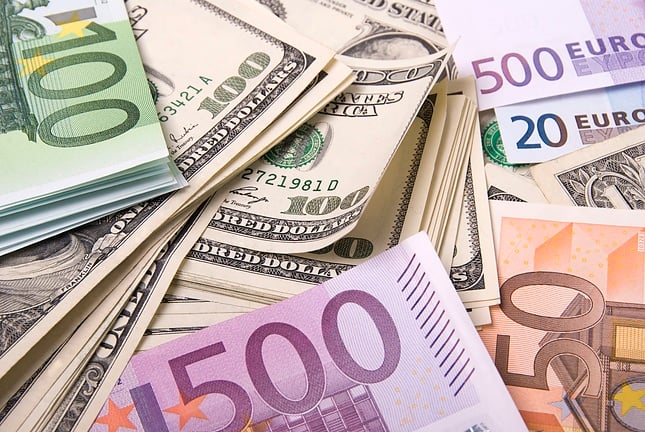- Indian Rupee gains traction, backed by lower US Treasury bond yields, weaker USD.
- India’s Wholesale Price Index (WPI) inflation remained in the deflationary zone in October.
- Indian Trade Balance and US Producer Price Index (PPI), Retail Sales will be due on Wednesday.
Indian Rupee (INR) trades firmly on Wednesday on the decline of US Treasury bond yields. On Tuesday, India’s inflation, as measured by the Wholesale Price Index (WPI), remained in the deflationary zone for the seventh month in a row in October, coming in at -0.52% versus -0.26% prior. That being said, the overall price development in manufactured products contributed to lower wholesale inflation in October. Nonetheless, India remains vulnerable to higher crude prices as India is the world's third-biggest oil consumer.
Market participants will keep an eye on the Indian Trade Balance for October. In the meantime, the Reserve Bank of India (RBI) is likely to intervene to prevent the volatility in the national currency, which might cap the INR’s depreciation in the near term. Also, the US Producer Price Index (PPI) and Retail Sales will be released later on Wednesday.
Daily Digest Market Movers: Indian Rupee trades strongly, US dollar declines on weaker US inflation data
- India's headline retail price inflation dropped to a four-month low of 4.9% in October from the previous reading of 5%.
- India's Wholesale Price Index (WPI) inflation came in at -0.52% versus -0.26% prior, below the estimations of -0.20%.
- India’s Consumer Price Index (CPI) climbed 4.87% YoY in October from the previous reading of 5.02%, above the market consensus of 4.80%.
- The Reserve Bank of India (RBI) has kept interest rates steady for four consecutive meetings and maintains a relatively hawkish policy stance to alleviate price pressures.
- RBI Governor Shaktikanta Das said India remains sensitive to food price shocks, and monetary policy continues to push inflation towards the 4% target.
- RBI forecasts India's GDP will expand at a 6.3% annual rate in the current fiscal year.
- US Consumer Price Index (CPI) grew 3.2% YoY in October from the previous reading of 3.7%, lower than the expectation of 3.3%.
- The US Core CPI, which excludes volatile food and energy prices, rose by 0.2% MoM and 4.0% YoY.
- Fed fund futures are now pricing no further US rate hikes in this cycle, according to the CME FedWatch Tool.
Technical Analysis: The Indian Rupee strengthens but the upside potential seems limited
The Indian Rupee trades firm on the day. The USD/INR pair has hovered around the lower limit of the trading range of 83.00–83.35 since late September. However, the USD/INR maintains a bullish vibe as the pair holds above the key 100- and 200-day Exponential Moving Averages (EMA) on the daily chart.
The initial support level for the pair is located near a low of September 12 at 82.82. Any follow-through selling will see losses extend to a low of September 22 at 82.75, followed by a low of August 4 at 82.65.
On the upside, the immediate upside barrier will emerge near the upper boundary of the trading range of 83.35. A break above 83.35 will see a rally to a year-to-date (YTD) high of 83.47. The additional upside filter to watch is a psychological round figure at 84.00.
US Dollar price in the last 7 days
The table below shows the percentage change of US Dollar (USD) against listed major currencies in the last 7 days. US Dollar was the weakest against the Euro.
| USD | EUR | GBP | CAD | AUD | JPY | NZD | CHF | |
| USD | -1.66% | -1.59% | -0.59% | -1.14% | 0.20% | -1.52% | -1.27% | |
| EUR | 1.64% | 0.08% | 1.07% | 0.52% | 1.84% | 0.15% | 0.40% | |
| GBP | 1.57% | -0.06% | 1.00% | 0.47% | 1.78% | 0.08% | 0.33% | |
| CAD | 0.58% | -1.08% | -1.01% | -0.54% | 0.78% | -0.94% | -0.68% | |
| AUD | 1.11% | -0.53% | -0.46% | 0.54% | 1.32% | -0.39% | -0.13% | |
| JPY | -0.20% | -1.87% | -1.81% | -0.78% | -1.37% | -1.72% | -1.47% | |
| NZD | 1.50% | -0.14% | -0.07% | 0.91% | 0.39% | 1.70% | 0.25% | |
| CHF | 1.27% | -0.37% | -0.30% | 0.69% | 0.14% | 1.47% | -0.24% |
The heat map shows percentage changes of major currencies against each other. The base currency is picked from the left column, while the quote currency is picked from the top row. For example, if you pick the Euro from the left column and move along the horizontal line to the Japanese Yen, the percentage change displayed in the box will represent EUR (base)/JPY (quote).
Indian Rupee FAQs
What are the key factors driving the Indian Rupee?
The Indian Rupee (INR) is one of the most sensitive currencies to external factors. The price of Crude Oil (the country is highly dependent on imported Oil), the value of the US Dollar – most trade is conducted in USD – and the level of foreign investment, are all influential. Direct intervention by the Reserve Bank of India (RBI) in FX markets to keep the exchange rate stable, as well as the level of interest rates set by the RBI, are further major influencing factors on the Rupee.
How do the decisions of the Reserve Bank of India impact the Indian Rupee?
The Reserve Bank of India (RBI) actively intervenes in forex markets to maintain a stable exchange rate, to help facilitate trade. In addition, the RBI tries to maintain the inflation rate at its 4% target by adjusting interest rates. Higher interest rates usually strengthen the Rupee. This is due to the role of the ‘carry trade’ in which investors borrow in countries with lower interest rates so as to place their money in countries’ offering relatively higher interest rates and profit from the difference.
What macroeconomic factors influence the value of the Indian Rupee?
Macroeconomic factors that influence the value of the Rupee include inflation, interest rates, the economic growth rate (GDP), the balance of trade, and inflows from foreign investment. A higher growth rate can lead to more overseas investment, pushing up demand for the Rupee. A less negative balance of trade will eventually lead to a stronger Rupee. Higher interest rates, especially real rates (interest rates less inflation) are also positive for the Rupee. A risk-on environment can lead to greater inflows of Foreign Direct and Indirect Investment (FDI and FII), which also benefit the Rupee.
How does inflation impact the Indian Rupee?
Higher inflation, particularly, if it is comparatively higher than India’s peers, is generally negative for the currency as it reflects devaluation through oversupply. Inflation also increases the cost of exports, leading to more Rupees being sold to purchase foreign imports, which is Rupee-negative. At the same time, higher inflation usually leads to the Reserve Bank of India (RBI) raising interest rates and this can be positive for the Rupee, due to increased demand from international investors. The opposite effect is true of lower inflation.
Information on these pages contains forward-looking statements that involve risks and uncertainties. Markets and instruments profiled on this page are for informational purposes only and should not in any way come across as a recommendation to buy or sell in these assets. You should do your own thorough research before making any investment decisions. FXStreet does not in any way guarantee that this information is free from mistakes, errors, or material misstatements. It also does not guarantee that this information is of a timely nature. Investing in Open Markets involves a great deal of risk, including the loss of all or a portion of your investment, as well as emotional distress. All risks, losses and costs associated with investing, including total loss of principal, are your responsibility. The views and opinions expressed in this article are those of the authors and do not necessarily reflect the official policy or position of FXStreet nor its advertisers. The author will not be held responsible for information that is found at the end of links posted on this page.
If not otherwise explicitly mentioned in the body of the article, at the time of writing, the author has no position in any stock mentioned in this article and no business relationship with any company mentioned. The author has not received compensation for writing this article, other than from FXStreet.
FXStreet and the author do not provide personalized recommendations. The author makes no representations as to the accuracy, completeness, or suitability of this information. FXStreet and the author will not be liable for any errors, omissions or any losses, injuries or damages arising from this information and its display or use. Errors and omissions excepted.
The author and FXStreet are not registered investment advisors and nothing in this article is intended to be investment advice.
Recommended content
Editors’ Picks

EUR/USD holds steady near 1.0500 ahead of FOMC Minutes
EUR/USD trades marginally higher on the day near 1.0500. The US Dollar struggles to preserve its strength amid a modest improvement seen in risk sentiment, helping EUR/USD hold its ground before the Fed publishes the minutes of the November policy meeting.

GBP/USD struggles to hold above 1.2600
GBP/USD loses its traction and trades below 1.2600 after rising above this level earlier in the day. Nevertheless, the pair's losses remain limited as the US Dollar struggles to find demand following mixed data releases. Markets await FOMC Minutes.

Gold under pressure below $2,630
Gold fluctuates above $2,600 on Tuesday after sliding almost three percent – a whopping $90 plus – on Monday due to rumors Israel and Hezbollah were on the verge of agreeing on a ceasefire. Whilst good news for Lebanon, this was not good news for Gold as it improved the outlook for geopolitical risk.

Trump shakes up markets again with “day one” tariff threats against CA, MX, CN
Pres-elect Trump reprised the ability from his first term to change the course of markets with a single post – this time from his Truth Social network; Threatening 25% tariffs "on Day One" against Mexico and Canada, and an additional 10% against China.

Eurozone PMI sounds the alarm about growth once more
The composite PMI dropped from 50 to 48.1, once more stressing growth concerns for the eurozone. Hard data has actually come in better than expected recently – so ahead of the December meeting, the ECB has to figure out whether this is the PMI crying wolf or whether it should take this signal seriously. We think it’s the latter.

Best Forex Brokers with Low Spreads
VERIFIED Low spreads are crucial for reducing trading costs. Explore top Forex brokers offering competitive spreads and high leverage. Compare options for EUR/USD, GBP/USD, USD/JPY, and Gold.